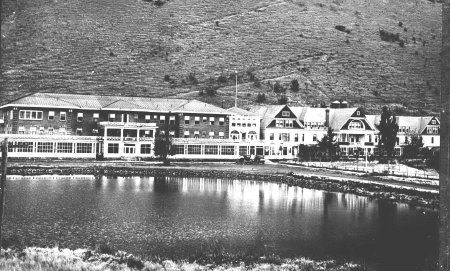The Hot Lake Hotel, originally built in the mid 19th century at the hot springs in La Grande, Oregon. Shortly after being built, the hotel was converted into a hospital, which was unfortunately destroyed in a fire, then was rebuilt as an insane asylum and was inevitably closed down completely. Years after it was closed, it was renovated and turned into the official Hot Lake Hotel, and with the colorful history that it boasted its haunted legend was born. The ghost stories include various sightings of apparitions and strange clouds of fog that suddenly appear, as well as disembodied voices, source-less piano music.
Ten miles outside of La Grande, in Union City, lies the Hot Lake Hotel–the area referred to as Hot Lake was discovered in 1912 by Robert Stuart who was part of the Wilson Price Hunt party. Before being discovered by the explorers, Native American tribes would bring their injured or sick to the hot springs to be nursed back to health on the neutral ground. It wasn’t until the 1840s that the hot springs at Hot Lake became a resting place for families who were traveling along the Oregon Trail. The original hotel at Hot Lake was constructed in 1864 and faced the bluff, instead of the lake, and it had bathhouses, a post office, a dance hall, a barbershop, and even a blacksmith. While the history between its construction in 1864 and 1884 is unknown due to its isolated nature, it was finally put on the map created by the Union Pacific railroad, which linked the state with the transcontinental system and attracted visitors from all around the globe.

In 1917, a man named Dr. Phy purchased the hotel and it took on a second purpose as a hospital on the third floor, with a surgery ward and recovery rooms for patients. It was renamed as the Hot Lake Sanatorium and eventually added modern x-ray facilities, was host to radiation therapies, as well as experimental treatments in the hot springs for various ailments. By 1924 the hospital/resort combination was attracting 124 new guests every day, with three hundred rooms, and dining facilities that served over one thousand guests. Its downfall came on May 7, 1934 when a fire broke out and all but the brick portions of the building were destroyed. The depression and debilitating fire caused the business to not recover for over seventy years, ownership changed hands multiple times, but every owner struggled to get the business back to its heyday.
With the second World War, the Hot Lake Hotel was converted into a pilot school and nurse training center, but when the war was finally over in 1953, the location was officially licensed for giving nursing care. It operated as a nursing home and an insane asylum until 1975 when it was closed; it was reopened as a restaurant, and country-western club for two years and then was promptly closed after the business failed. Dr. Lyle Griffith took over the location in 1983, with the establishment of the Hot Lake Company and operated a bath and massage business–an RV park was also built on the premises in 1989, but the business closed once again in 1991 and the building fell into major disrepair.
Haunted Facilities…
The reputation of Hot Lake Hotel, however, by this time had become one of extreme haunting–having such a history as a hospital and sanitarium, it’s fair to assume that quite a few people died on the premises. The years have lent to quite a few witnesses alluding to the haunting of the facilities, having heard and viewed things they could not explain all over the premises, including apparitions walking the grounds, strange voices, whispering, as well as footsteps within the hotel. One apparition, in particular, that is regularly reported is believed to be the ghost of a man who worked as a gardener and ended up committing suicide.
First-hand experiences…
A brother and sister drove to the state just to see the Hot Lake Hotel in 2000 and toured the facility on their own. They felt that the abandoned location was quite eerie, but did not report any real apparitions. The piano that is heard playing without a pianist was originally owned by Robert E. Lee’s wife and was then acquired by the hotel, it was placed on the third floor, and to this day the piano is heard playing itself. One of the owners, Donna Pattee, her husband, and their caretaker Richard Owens reported having several strange experiences while they lived on the second floor during the 1970s; they heard screams and cries coming from the third floor–previously the surgical floor, as well as watching rocking chairs moving on their own. The building was officially put on the National Register of Historic Places in 1979. In 2003, the Hot Lake Hotel was purchased by the Manuel family and they spent indeterminable millions of dollars to restore the property over the next seven years. They formally opened the gallery and foundry for visitors in 2005 and began offering tours of the location during the restoration process.

Georgia-based author and artist, Mary has been a horror aficionado since the mid-2000s. Originally a hobby artist and writer, she found her niche in the horror industry in late 2019 and hasn’t looked back since. Mary’s evolution into a horror expert allowed her to express herself truly for the first time in her life. Now, she prides herself on indulging in the stuff of nightmares.
Mary also moonlights as a content creator across multiple social media platforms—breaking down horror tropes on YouTube, as well as playing horror games and broadcasting live digital art sessions on Twitch.

